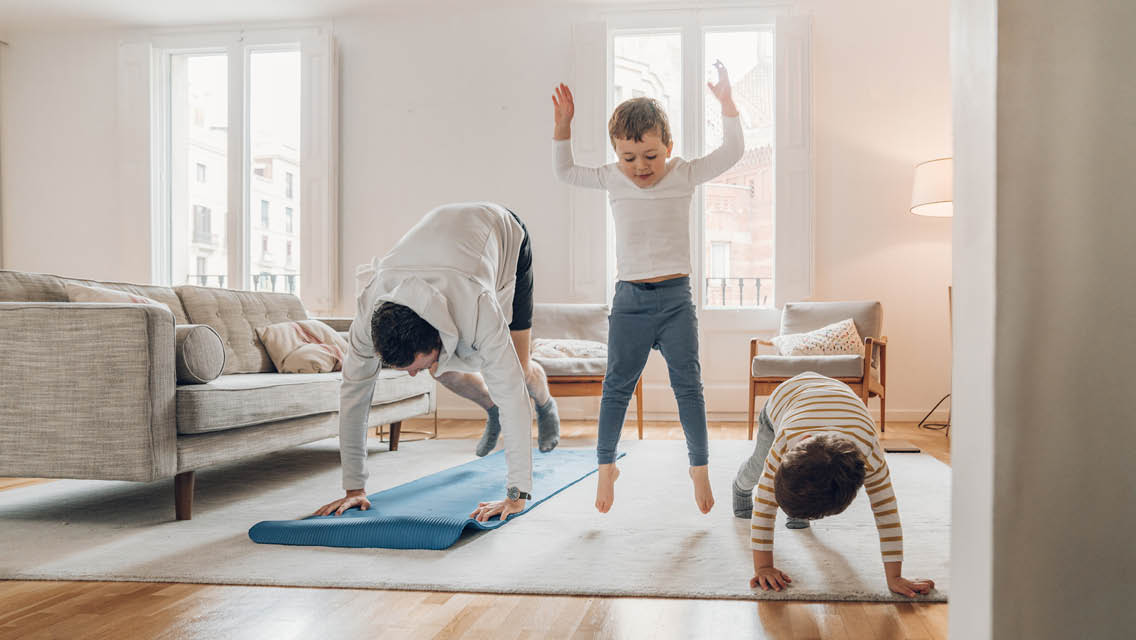As a parent, you are one of the biggest role models in your child’s life — they learn so much by watching what you do every day. So when it comes to healthy eating, physical activity, screentime usage, and other behaviors, parents have a huge opportunity to be a positive influence.
We asked two experts (and moms) from the Life Time Kids program about the significance of modeling healthy behaviors for kids and how they promote healthy habits within their own families. This is what they had to say.
Expert panelists:
- Shelly Forsberg, director of kids programming at Life Time
- Samantha Stark, senior director of kids and aquatics programs at Life Time
Why is it important to demonstrate healthy habits for your kids?
“It’s important to practice what you preach,” says Forsberg, who has three boys ages 14 (twins) and 12. “If you’re not doing what you’re saying, it’s not believable and your kids will see through it. Kids often want to act older and feel like they’re moving up in life. Whatever they see their parents doing, they want to do, too. They don’t know any different and will continue to copy what they see.”
How can I model healthy eating for my kids?
Getting kids to eat healthy is all about exposure, not force. Provide a variety of whole foods for them to try, rather than sticking with your traditional “kids” foods such as chicken fingers and macaroni and cheese. “I always encourage my kids to try at least one bite of everything we make at home,” says Forsberg. “If they don’t like it, they don’t have to eat it, but the key is to try.”
Limiting the amount of junk food in your house is also important. If it’s there, it’s tempting. “We try to teach our kids that treats are OK every once in a while, but we make sure to stock up on fresh, whole foods for meals and snacks,” says Stark, mom of four who are ages 6, 11, 14, and 17.
(Looking for more help in this area? Here are four strategies to try.)
How can I involve my kids in cooking and mealtimes?
Including your kids in the cooking and meal-planning process can have a huge impact on their willingness to try new foods.
“I let my kids help pick meals and do the shopping with me,” says Forsberg. “This gives them experience with reading recipes, finding the ingredients, and understanding the cost. We also rotate who cleans up after meals; whoever helps prepare the meal doesn’t have to help with cleaning up.”
While meal planning, give your kids a few healthy options and let them choose what you’ll eat as a family. Try colorful, kid-friendly recipes that are easy to cook together. You can even turn it into an educational activity, working on fractions and measuring ingredients, or an opportunity to hone fine motor skills with measuring, peeling, and chopping. (Investing in some kid-friendly utensils and kitchen tools will keep this safe and fun.)
Once you sit down to eat, make family mealtime fun with these helpful tips.
How can I model healthy physical activity?
Make physical activity part of your family’s everyday routine. One of the easiest ways to do this is including your kids in your own fitness regimen. “Whenever I work out or go to Life Time, I encourage my kids to come along,” says Forsberg. “They can choose to take a class, climb, swim, or shoot hoops, and the younger ones can have fun in the Child Center.”
Stark adds: “Get down and play with your kids. Help them find their passion by letting them try new things and showing them what you do to stay active. When they see the positive impact that physical activity has on their parents, they’ll want to get involved too.”
It’s also essential to show exercise in a positive light — as something you get to do, rather than as something that you have to do. Help your kids understand how activity helps you live a long, healthy life — physically, mentally, and emotionally — by talking about its benefits. When you teach them how important it is and make it a regular part of your family’s routine, they’re more likely to maintain the habit throughout their life.
How do I help my kids create a healthy sleep and bedtime routine?
Routine is crucial. “A bedtime ritual helps kids know what to expect every night, and that includes focusing on an early — yet reasonable — bedtime,” says Stark. “We set aside time for relaxation and downtime without technology before we go to bed.”
Try to stick to a rule of no screen time in the hour before bed. This will help every family member sleep better and wake up refreshed for the next day.
What are other ways I can make our home environment healthy?
Create a positive home environment by letting your kids know they’re in a safe, relaxing place. “You can teach and demonstrate healthy habits, but kids need a warm, loving environment to thrive,” says Forsberg. “School and sports environments can be so competitive, and you don’t want your kids to feel burnt out.”
In addition, be mindful of the amount of time you spend on your own phone or other devices. Aim to spend quality time as a family each day with all cell phones and devices put away.
And spend individual time with each child, giving them an opportunity to open up and talk about their lives. “I encourage my kids to walk the dog with me, and we use it as one-on-one time to build closeness,” says Forsberg.





